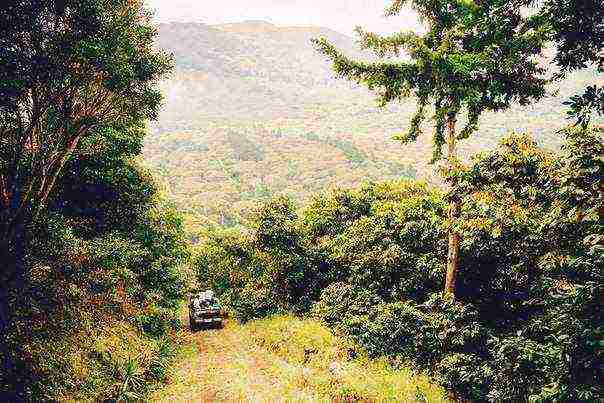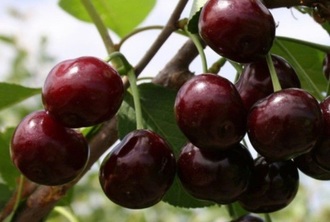Content
For connoisseurs, amateurs and just interested.
Coffee trees are difficult to classify due to their extreme variety. In total, there are about eighty types of coffee trees - from dwarf shrubs to 10-meter giants, among which there are only 4 main types. Of these, only two botanical species of coffee trees are of interest to coffee lovers - Coffea Arabica, also called Arabian coffee, and Coffea Canephora (Robusta), sometimes called Congolese coffee.
The other two varieties of the coffee tree are Coffea Liberica (Liberica), discovered in Liberia in 1843, and Coffea Dewevrei, of which Excelsa is the most famous subspecies. These two varieties have Robusta qualities and a perfectly acceptable, although not very pleasant taste.
It is necessary to understand the difference between the concepts of “type of coffee” and “type of coffee”. Calling Arabica, Robusta, Liberica or Excelsa a variety is wrong - these are species, or rather varieties of the coffee tree. Each species has many varieties.
ARABICA The plant's official name is Coffea Arabica. Arabica, the most important coffee in the world, has a complex aroma and taste.
The Arabica tree is naturally 6-8 meters high (however, the tree is not allowed to grow more than 4 meters for easy harvesting). The Arabian tree blooms with white fragrant flowers, 3-7 pieces in the corners of the leaves. The Arabica fruit is 14 millimeters long, red in color, and at the end of ripening it is purple. Seeds are elongated, flat-convex, facing each other with flat sides, on which a longitudinal furrow is noticeable.
The Arabica tree usually yields no more than 5 kg of fruit per year, from which about 1 kg of ready-made grains is obtained. Arabica beans are larger, longer and smoother than Robusta beans, and are also less caffeine-rich.
Arabica fruits contain: 18% aromatic oils, 1-1.5% caffeine. The taste of coffee made from Arabica is sweet, with a slight sourness. The best beans are produced by the varieties of Arabica: Typica, Bourbon and Maragogyip.
Arabica makes up almost 70% of all coffee produced in the world. The number of Arabian tree varieties that are used today in the coffee industry is 45-50. However, it is quite difficult to grow it as it is very susceptible to disease, pests and frost.
ROBUSTA The plant's official name is Coffea Canephora. Discovered in the Congo Basin (Congo, Africa). Robusta, the second most popular type of coffee in the world, is characterized by a high caffeine content in beans.
Coffee made from the fruits of Kanefora has a lower aroma and greater strength than Arabica, besides, the plant perfectly resists diseases and insects. However, the strength of coffee is by no means its most important characteristic, and Robusta tastes less than Arabica. Due to this, Robusta accounts for only 30 percent of the world's coffee.
Robusta grows at an altitude of 200-900 m above sea level, and is more resistant to changes in temperature and rainfall than Arabica. The Robusta coffee tree is insensitive to diseases and harmful insects. The plantations do not require careful maintenance and are distinguished by high yields.
Robusta fruits contain: 8% aromatic oils, 3% caffeine. In the production of Robusta it is used mainly in blends and for the production of instant coffee.
LIBERICA The official name of the plant - Liberian coffee tree (Coffea Liberica). Liberian coffee is originally from West Africa. Currently, this type is grown in almost all countries of the African continent, as well as Sri Lanka, Indonesia, the Philippines and others.
Liberica get coffee from the coffee cherries 6-10 meters tall with very large leaves. Length coffee fruit - 30-35 mm, width - 10-15 mm.
Liberica resistant to all diseases of coffee trees but irzhevogo fungus.
Liberica fruit quality is not very high, so this kind of coffee is rarely used. Basically Liberica used to create various mixtures.
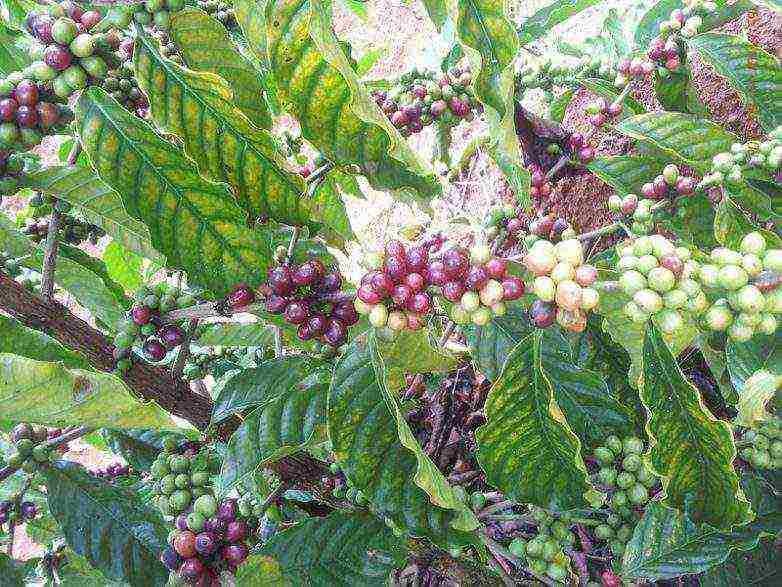
EKSTSELSA The official name of plants - Coffea Dewevrei. Another type of coffee. Excelsa Coffee - or Coffee High - is even less well known than Liberica. Trees of this species reach a height of 20 m. This type of coffee has no economic value. The most commonly used as a component of elite coffee blends to enhance the flavor of the beverage.
The main types of coffee are Arabica and Robusta. In turn, these species are divided into a large number of varieties differing in their characteristics, taste, aroma and the price accordingly.
The names of the different varieties are: - the country of origin;
- at the port from which the supply;
- subspecies of the coffee tree (Bourbon, Typica, etc.);
- the title farms, estates, property, where the coffee is grown;
- by the name of the area, mountain, valley or nearby city;
- as a commercial name;
- according to the national classification system as the country of origin;
Also, there are many different classifications of coffee beans grown in quality. In different countries, different conduct such a classification:
- SHG (Strictly High Grown), the coffee grown in the mountains;
- HG (High Grown), the coffee grown in the foothills;
- MG (Medium Grown) or CS (Central Standard), coffee grown on lowland plantations;
- SHB (Strictly Hard Bean) ,. coffee with a very solid grain;
- HB (Hard Bean), coffee with solid grain;
Quality: - A - the best quality coffee;
- B - average quality;
- C- low quality coffee;
- AA - the best coffee;
- AB - good coffee;
- BA - coffee of average quality;
- BB - poor quality coffee.
Also, some varieties of coffee, you can see the special marking of the "preparation" of grain, which means that the grain is passed manual process of removing the defective beans and foreign objects (stones, etc.):
- AP (American preparation) - American training to remove up to 23 defects in 300 g of grain;
- EP (European preparation) - European training, allowing to remove defects in 8 300g grain.
Almost all the berries of coffee trees contain two seed, but there are times when only one fused grains in the coffee cherry. These grains are manually selected, labeled PB (Peaberry) (from English. Peas), and are sold as a single type of coffee. Peaberry is 5% of any crop of coffee.
Coffee Asia and Australia«Arabica Yemen Mocha Mattari» The first type of coffee, which met the Europeans. Best of Yemeni coffees that is going in the northern mountainous part of Yemen in Mattari area near Sana'a at an altitude of 1000-2000 m. This is the first type of coffee, imported into Russia. It was his drinking Russian and European monarchs. Hence, the second name of the class - "Coffee Lords." Mattari Mocha coffee flavor rich, tangy, with chocolate flavor, fragrance - a subtle, fruity wine, with smoky undertones. The unique, slightly noticeable acidity gives the drink a mild and delicious taste, with a long aftertaste of chocolate.
«Arabica India Monsooned Malabar» The most interesting variety of Indian Arabica coffee from Malabar, where it is grown on a small farm, placed in BCF bags and stored in the barn from June to November, when the monsoon winds blow. Grain from rains gaining moisture and increase in volume doubled, acquiring a yellowish-brown color (for regular coffee it is green). This method of processing coffee came with the development of high-speed ships. In the days of sailing navigation, grain traveled for many weeks, and during that time have time to turn yellow and to get a special taste.After their journey to Europe was shortened, the locals had to resort to a special "monsoon" treatment in order to preserve the taste and type of coffee familiar to Europeans.
Moderate acidity, medium and thick texture, balanced sweet taste, pleasant aroma of nutmeg, chocolate tones will not leave anyone indifferent.
"Arabica Kopi Luwak" The coffee is very expensive and extremely rare.
Coffee gourmets appreciate Kopi Luwak for its unique taste and aromatic aroma. Indeed, having sniffed the packaging valve, even an inexperienced nose will feel the richness and variety of aromas of coffee beans. It is believed that it has its original taste thanks to a very unusual way of fermenting coffee beans and collecting them. The Kopi Luwak coffee bean production process involves small animals (palm civetti) eating the fruit of the coffee tree (coffee cherries), digesting and excreting them. These beans are then harvested and used to make coffee. It is this special process of coffee production that explains its high price and rarity.
The special brightness of the taste of Kopi Luwak coffee is explained by the properties of the animal's gastric juice, which contains a substance rich in aroma - civet. In addition, when choosing fruits, civetti uses not only their eyes, like people, but also their nose, choosing the best berries. Due to this, the grains of this variety are superior in quality to any other variety.
Kopi Luwak has special, expressive features of taste: chocolate aroma, delicate bitterness, hints of butter, nougat and honey, as well as a long and persistent aftertaste for many hours.
Arabica Nepal Everest The only coffee in the world growing north of the Tropic of Cancer, Arabica from a small plantation in Nuwakot County.
The delicate, perfectly balanced taste of Nepal Everest is incredibly rich. Connoisseurs and gourmets distinguish in it a slight sourness and at the same time a noble bitter tint, as well as unusual sweet-salty notes. The finish carries fruity-floral notes of jasmine, citrus, hazelnuts, and fresh coriander.
The unique character of this unusually rich coffee opens up to coffee gourmets noble aromas of cocoa and candy, changing with exquisite notes of ginger in the taste.
"Arabica PNG" An exotic and high quality variety of highland Arabica. It is a cultural variation of Blue Mountain Arabica brought to New Guinea from Jamaica.
This type of coffee is considered one of the best due to its high consistency and pleasant sweetish taste. The coffee is well balanced and has strong fruity notes.
Differs in good consistency and sweetish taste. This variety is used in pure form and in mixtures due to its very high quality.
A drink of medium acidity, with a nutty aroma and pleasant taste, tart, with a slight bitterness.
Robusta India Parchment Has a pleasant chocolate aroma with wine tones, gives a bitter, highly saturated infusion, with a high caffeine content. The aftertaste is bright, very long. It is most often used for the preparation of mixtures.
"Robusta India Cherry" It has a rich aroma and gives a medium-rich bitter infusion with an almost imperceptible acidity. Although it is almost never consumed in its pure form, gourmets recognize the Robusta India Cherry variety and recommend it to lovers of very strong coffee.
South America Coffee"Arabica Bolivia" The coffee has a silky creamy taste, intensely spicy aromas with notes of jasmine, peach, cedar and vanilla. Rich taste with light sourness of apricot, black currant and red grapes. This is one of the best examples of classic coffee from South America, has a bright, juicy acidity and clean taste. The characteristic flavor for this typically South American coffee comes from the wet processing of the beans.
Arabica Brazil Santos The most famous variety of Brazilian Arabica. The taste is rich, moderately sour, with sweet notes and hints of dry spices. The aroma is subtle, balanced.The drink obtained from this variety has a mild, pleasant taste. Santos imparts a mild aroma, tasty richness and moderate acidity to the drink. Brazil Santos is distinguished by its special softness, stability of taste, coffee character, which does not have any extraneous flavors. There is a balance of sourness and bitterness.
The variety is recommended for those who do not like exotic, but prefer classic coffee. Well suited as a component for making coffee blends. The grain size of this variety is the standard for all other varieties.
"Arabica Brazil Yellow Bourbon" One of the best Brazilian coffees named for the French island of Bourbon in the Caribbean. This variety has a clean, neutral, slightly sweet aroma, and a rich neutral flavor. A distinctive feature of Bourbon is a refined, sweetish-bitter, slightly oily taste with a slight acidity, which is completely absent in ordinary Santos.
True Bourbon is harvested from coffee trees only during the first three harvests. After four years, the grains change their characteristics and become similar in taste to ordinary Santos.
Yellow Bourbon is a unique coffee that has not undergone any crossing procedures.
Berries of this variety are yellow in color and their skin is thinner than that of other varieties of coffee. It allows the sun's rays to effectively affect ripening berries and grains, making them especially sweet.
This is a unique coffee that has an incredibly balanced and very rich taste. When properly roasted, this coffee is very sweet and can be drunk without sugar.
Arabica Ecuador Galapagos A rare and very unusual type of coffee, grown without the use of chemicals. Coffee is grown in extremely limited quantities. Thanks to the truly unique climatic conditions and distinctive traditions of collection and processing, this coffee cannot be compared with any of the famous coffees. Delightful aroma with hints of dark chocolate, well balanced; on the palate - cocoa and caramel, pleasant floral sourness. It has an exquisite aroma and rich taste with a soft nutty nuance.
Arabica Colombia Excelso One of the most popular coffees in the world, with a well-balanced taste, it has a delicate, pleasant aroma with a mild fruity flavor and higher acidity than Colombia Supremo. Harmonious aroma, pleasant aftertaste.
This type of coffee is distinguished by an excellent combination of coffee qualities: taste, aroma, consistency and color, which turns into a sunny golden color when a little milk or cream is added to the drink. A slight sourness inherent in all varieties of Colombian coffee is present in the drink.
"Arabica Colombia Supremo" Supremo translated from Spanish means "magnificent". This coffee has a wonderful velvety taste, slightly sweet with a slight pleasant sourness of fruity wine. Undoubtedly, the coffee is of the highest standard. It will immediately win your heart with a rich and bright bouquet of flavors.
The taste and aroma of this variety are suitable for preparing coffee in a wide variety of ways.
"Arabica Colombia Maragogype" It is made from large grains of Colombian Arabica grown on high mountain plantations. Hand picking of beans and traditional processing make this coffee truly precious.
The drink made from this type of coffee has a bright rich aroma with hints of baked milk and a thick dense taste with a slight bitterness.
Central America CoffeeArabica Guatemala Antigua A variety of coffee grown in the vicinity of the city with the same name is distinguished by a tangible bitterness with a prune flavor. Well noticeable citrus acidity, medium to thick texture, good balance, chocolate and spicy notes. The aroma of this coffee can be described as sweet and sour, floral. The taste is bright, rich, impetuous, with a barely perceptible noble bitterness.
Coffee in Guatemala is grown on the slopes of volcanic mountains, where nature has created almost ideal conditions for obtaining high-quality Arabica beans. The best Guatemalan coffees have a pronounced spicy, chocolate or "smoky" aroma - a consequence of the volcanic soil on which the coffee trees grow.
Arabica Guatemala Maragogype It is one of the best varieties of this variety and originates from the Brazilian variety of the same name.
Guatemalan coffee is characterized by increased acidity compared to neutral Arabica coffees, therefore, it goes well with them, and also with bitter varieties. It has a pronounced pungent taste, high acidity and a special, smoky flavor. The infusion is rich, with a long soft taste. The bouquet is rich, complex with fruity, floral and smoky undertones.
Arabica Costa-Rica Tarrazu Intense and rich, with a light, clean taste and wonderful aroma. The peculiarity of this variety is that the coffee retains all the richness of taste and aroma, even when it is cold! It is this variety that is most often used in the preparation of soft drinks from coffee. The taste is rich, intense, similar to old Burgundy wine, with a slight sourness. The aroma is soft, pronounced, long aftertaste, exceptionally full saturation. Excellent coffee with a distinct wine tint and a clean flavor. Intense, soft taste with hints of hot spices, has a delicate, delicate aroma.
Arabica Costa-Rica Has a reputation as one of the best coffees due to its excellent aroma and pronounced walnut flavor. Grows in humid tropics, where there is a lot of sun and frequent rain. It is low in caffeine.
The drink turns out to be quite strong, even burning, with a bright aroma. The largest grains grown at an altitude of over 1,500 meters above sea level are selected; their taste is softer. The coffee is highly acidic and creates a silky piquancy in the taste.
Rich, mild taste with hints of hot spices, high density - these are the distinctive features of this variety.
Arabica Jamaica Blue Mountain One of the rarest and most respected coffees in the world that has long been unrivaled. Grows in the mountainous area of Blue Mountain at an altitude of 2256 meters above sea level. The grains have a characteristic blue-green color. The main advantages of this variety include the quality of care, processing and sorting of exported coffee and, accordingly, the quality of the final product. Blue Mountain coffee is virtually unavailable on the international market.
The grains have a delicate delicate aroma, delicate taste with nutty nuances and subtle sourness. The fullest coffee taste appears when the volume of ground coffee for one portion is increased by 15-20%. Distinctive features of properly prepared coffee of this sort are - not very dense consistency, no obvious bitterness, balanced combination of classic taste with a light nutty aroma and a distinctly noticeable fruit flavor, moderate acidity, sweetness.

Africa coffee"Arabica Zimbabwe" Coffee has a delicate floral aroma, wine and berry tones balance with the taste of spices. The coffee is distinguished by a soft, harmonious acidity with a touch of sweet caramel and dark chocolate, as well as an even, delicate, slightly fruity aftertaste.
"Arabica Kenya" Kenyan Arabica is globally recognized as one of the most prestigious coffees in the world. It has astringency, pleasant pungency, strength, wine aftertaste and an excellent subtle, pronounced, bready aroma.
Arabica Rwanda Has the aroma of fresh bread with hints of milk chocolate. The taste of a young wine with a noticeable acidity, a slight aftertaste of green apples and a long fruity aftertaste is an amazing feature of the variety. The drink is balanced, medium strength, full-bodied, buttery, with clear notes of vanilla.
Arabica Ethiopia Sidamo The infusion is thick, with a long aftertaste. The aroma is delicate, pronounced, with a fruity tint. Refers to soft coffee varieties. At first it is very soft and delicate, then it becomes much denser. In the aroma of coffee, experts distinguish notes of bergamot, apricot and blueberry tones, as well as hints of vanilla and cocoa. The aftertaste of Ethiopia Sidamo is characterized by aromas of toasted bread, caramel, rose and fresh cream.
How to choose? (we will talk about coffee beans)1. Appearance: - The size. If you buy 100% Arabica, then all the beans must be the same size and shape. If you see small grains in this mixture, then there is a possibility that cheap Robusta has been added.
- Form. The grains should be of the correct shape of the beans, they should be pleasant and velvety to the touch. The grains should not be stained and chipped, small pieces of beans are completely excluded. The only thing that you can see grains of different colors in the melange mixture. This is due to the fact that it combines varieties of different degrees of roast.
- The aroma of quality beans should always be strong, without a hint of bitterness. If you hear a smell of rancidity or mildew, it means that the shelf life of such coffee has long passed.
2. Packing: It should be airtight - preferably from a three-layer foil with a valve, which is necessary not only for assessing the aroma, but also for the release of carbon dioxide released during frying of the grains.
3. Degree of roasting: Displayed on the packaging as numbers - from 1 (low roast) to 5 (strong roast);
The choice in this case depends solely on taste preferences, however, pay attention to the roasting date, remembering that roasted beans retain their aroma for a month, and the more time has passed since that moment, the more coffee loses in terms of its taste.
Roasting degrees: - Scandinavian (super light) roast gives the coffee tenderness and softness, the color of the beans is light brown, almost beige.
- American (medium) roast contributes to the appearance of a slight bitterness in the taste, the color of the beans is rich brown, but this type of roasting does not allow the appearance of essential oils on the surface of the beans, therefore the taste and aroma are revealed only by a slight hint.
- Viennese roast - the beans darken and become shiny due to the manifestation of essential oils, sweetish notes appear in the coffee taste.
- French (strong) roast gives the beans an intense chocolate color, and the taste acquires a pleasant bitterness and astringency.
- Italian (very strong) roast is recognizable by the black oily grains, and the drink acquires special expressiveness, velvety and richness - this is a real bitter coffee in the classic version.
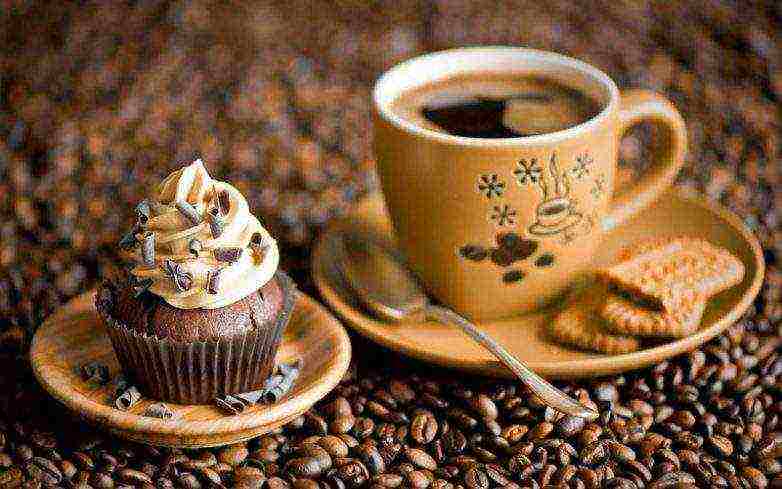
Of all the varieties of coffee trees, Arabica is the most in demand. All kinds of drinks and different types of coffee are made from its seeds. Arabica plantations provide up to 70% of the world's coffee reserves every year. Being the most beloved and widespread drink of the population of our planet, arabica is one of the most expensive types of coffee. This is due to the fact that the cultivation of Arabica, which is sensitive to the effects of insects and pests, requires large expenditures for the purchase of fertilizers and insecticides. Arabica: about cultivation and distribution
In its historical homeland - in the river lowlands of the Kafa province in southwestern Ethiopia - at an altitude of 2 km above sea level, there are still wild thickets of this plant.
At the end of the 19th century, many farmers were forced to abandon the cultivation of Arabica due to its many diseases, preferring other crops. At that moment, Indonesia began to grow the Congolese robusta coffee tree, which had not only a high yield, but also an amazing resistance to diseases, but the drink made from it was of poor quality.
Until the middle of the 20th century, Arabica breeders worked in three directions, trying to adapt the plant to grow in local conditions, simultaneously increasing its yield and improving the quality of the drink. Two decades later, breeders in many countries have adopted a program to help increase the disease resistance of Arabica beans.
The tropical climate of Africa and Asia is most comfortable for Arabica. To facilitate the collection of fruits, plants are cut to 2-3 meters (in the wild, it can stretch up to six meters). Arabica plantations are best placed in the mountainous tropics (optimal altitude 900-2100 meters above sea level) with regular abundant rainfall and an average temperature range of 15 to 24 degrees Celsius. The main condition for successful cultivation is the complete absence of the threat of frost.
Since the substrate for Arabica cultivation must be fertile, saturated with minerals, it is regularly fertilized throughout the year. Given the high sensitivity of Arabica to diseases, many fungicides and pesticides are systematically used to prevent them.
Video: Morning with the Gubernia. How to choose the right coffee?
Blooming Arabica is incredibly good: the bright green gloss of the leaves contrasts with the gray bark and whiteness of the fragrant flowers. On the tree, they constantly coexist with fruits - purple or red berries. There are two small grains inside them. Peeled off, they are marketed both raw and fried. Harvesting on plantations has its own specifics. Since fruit setting occurs throughout the year (it takes from six months to 8 months to ripen), fruits, ovaries, and flowers coexist on the branches at the same time. Under these conditions, mechanized harvesting is simply impossible. That is why in most states that cultivate Arabica, ripe fruits are harvested either by hand or shaken off on special mats. The only exception is Brazil, whose climatic conditions contribute to the simultaneous ripening of all fruits: there harvesting is mechanized.
The collected coffee berries are immediately processed, separating them from the cornea. On plantations, this is done either wet or dry. Depending on this, Arabica is "dry", "completely washed" and "half washed". The basis for choosing a method for processing fruits is the availability of water at the point of their collection. The quality of processing is also influenced by whether the plantations have the appropriate equipment. Historically, Brazilian and Ethiopian Arabica beans are dry processed. On the plantations of other states, they prefer to resort to the wet method.
Arabica beans contain: up to 2% caffeine, 18% aromatic oils, 12% fat, 13% protein, 8% sugar. Roasting the beans reduces the caffeine content by up to 1.2% and the sugar content by up to 3%. The caffeine content of Arabica beans is in direct proportion to the geographic location of the area in which they were grown. This characteristic can be influenced by: altitude, proximity to the equator, the chemical composition of the soil. Thus, the amount of caffeine in a drink made from beans grown in highlands is two times less than in coffee made from "plain" Arabica. This knowledge can help you when choosing coffee beans. To create a light tonic effect, "mountain" Arabica is suitable, for a more effective stimulating effect, it is better to choose Arabica grown in the valleys.
Video: Coffee for a coffee machine. What is the best coffee?
Arabica is traded through a very large coffee exchange based in New York. This is a tribute to the tradition established back in 1882. It was then that the New York Coffee Exchange set its first pricing for this product. The pound became the weighting unit for the Arabica trade. Arabica storage places are ancient port cities: Trieste, Amsterdam, Bremen, Hamburg, Rotterdam, London.Arabica is the best choice for those coffee connoisseurs who seek to minimize the effect of caffeine on the functioning of the heart muscle.
Which Arabica is Better?
Brazilian
Brazil is the main supplier of Arabica. While a decent product, Brazilian Arabica is not an expensive elite variety. It is in demand among people who are not coffee gourmets and who value this drink for its democratic prices.
Venezuelan
Not the highest quality product. The taste of a ready-made drink made from this type of coffee will not delight anyone, although it is still suitable for everyday use.
Vietnamese
Specializing in robusta, Vietnam does not grow too much Arabica. There are many contradictions in the views on the taste and quality of this product. Vietnamese arabica beans sold in Russian supermarkets are not of high quality, but reviews of Vietnamese coffee made by many tourists who have visited this country are full of rave reviews. Most likely, the freshness factor of roasting coffee beans is of primary importance.
Guatemalan
Produced in large quantities, the Guatemalan Arabica varieties are of good quality. The drink made from these grains is distinguished by its strength and special aroma.
Zambian
The best Arabica varieties of the African region are grown in this country, but weather conditions do not always contribute to obtaining high-quality beans. Treasured by its reputation, the state does not supply the foreign market with the harvest of an unsuccessful year, so it is almost impossible to buy low-quality Zambian arabica in a supermarket. Seeing it on the counter - buy without thinking too much: it does not go on sale often.
Zimbabwean
The coffee grown in this African state does not have a special quality. The only exception is one of its varieties - Zimbabwe AA Salimba. Distinctive features of its taste are: rich aroma, slight acidity and fruity taste with bitterness. Unfortunately, due to the lack of access to the sea, Zimbabwe is forced to transport its Arabica through other countries, which often ends up in damage to the valuable cargo.
Indian
Arabica of the Mysore variety, the unique features of which are: wine acidity, pleasant taste and pronounced aroma, should certainly be appreciated.
Indonesian
Indonesia is home to many famous varieties. The grains grown on different islands have a completely different taste and, of course, are of the highest quality.
Yemeni
Here they grow coffee of the very famous and incredibly popular Arabien Mokko variety. The appearance of the beans - heterogeneous, with a lot of debris - should not be off-putting, as they make a great chocolate-flavored drink.
Kenyan
Perhaps the best Arabica in the world. The best known variety is Kenya Ruiruiru, sold only raw. Its real taste is revealed only after frying. A few hours later, there will be no trace of its scent.
Colombian
Top quality coffee of the highest quality, the beans of which are matched one to one. The inscription "supremo" on the package indicates the highest grade, "extra" - a lower rank, but also very worthy, "excelso" - a blend of the first two grades.
 For centuries, coffee has remained the favorite drink of mankind. The homeland of coffee trees is Ethiopia, Africa, but later they spread throughout the world. Moreover, grains are one of the main products of world trade, second only to oil. The main volume of coffee is produced by hot tropical countries: Brazil, Colombia and Vietnam, but today coffee plantations can also be found in Australia or China, as well as, surprisingly, in some European countries. Trees requiring special care are grown by experienced specialists in their field in certain soils, and coffee berries, when ripe, are harvested by hand.Later, they make such a beloved drink, without a cup of which many cannot imagine the beginning of a new day.
For centuries, coffee has remained the favorite drink of mankind. The homeland of coffee trees is Ethiopia, Africa, but later they spread throughout the world. Moreover, grains are one of the main products of world trade, second only to oil. The main volume of coffee is produced by hot tropical countries: Brazil, Colombia and Vietnam, but today coffee plantations can also be found in Australia or China, as well as, surprisingly, in some European countries. Trees requiring special care are grown by experienced specialists in their field in certain soils, and coffee berries, when ripe, are harvested by hand.Later, they make such a beloved drink, without a cup of which many cannot imagine the beginning of a new day.
Arabica coffee: main characteristics and growing regions
Arabica and robusta ... you see these words all the time when you buy or order a cup of coffee in a cafe. It is no secret that they represent the names of two main varieties. So what's the difference? Arabica coffee is more expensive and has a subtle, sweet, but at the same time quite intense aroma. The smell can have hints of caramel, honey, spice or fruit. The trees on which Arabica coffee is grown are very capricious and require special soil, air humidity and specific climatic conditions. The best Arabica coffees come from Brazil, Costa Rica, Colombia, Guatemala, Kenya and Ethiopia.
Robusta coffee
In contrast to the aristocratic refinement of Arabica, the Robusta variety has a more bitter, so to speak "earthy" taste with a woody, slightly astringent undertone. In general, Robusta has much less aroma characteristics than Arabica coffee. That is why this variety is not particularly represented on the market, although it is quite cheap. Robusta trees are much less capricious than their species counterparts, they do not require any specific growing conditions, are frost-resistant and widespread. As a rule, well-known cafes and restaurants do not offer their visitors this type of coffee.
How to choose the best Arabica coffee
 Please note, not all Arabica coffees are created equal. They can also be grown in inappropriate conditions, which undoubtedly affect the taste of the drink (as we remember, coffee trees are very capricious), harvested at the wrong time of ripening, are prone to improper storage or roasting. Therefore, the words "this is Arabica" do not yet mean that you will get high-quality aromatic coffee from the beans. When choosing beans, first of all pay attention to their aroma: coffee should not smell of burnt beans. If this is the case, then there have been gross violations in the roasting: they must be dry, without visible changes or damage. Also look at the country of manufacture: today Brazil and other Central American countries supply the best Arabica to the world market. Also one of the determining factors is the price, which on average starts from $ 50 per kilogram of good coffee. And the most refined and expensive varieties today are Jamaican Blue Mountain, Tarrazú, Colombian Supremo, Costa Rica, Guatemalan Antigua and some others.
Please note, not all Arabica coffees are created equal. They can also be grown in inappropriate conditions, which undoubtedly affect the taste of the drink (as we remember, coffee trees are very capricious), harvested at the wrong time of ripening, are prone to improper storage or roasting. Therefore, the words "this is Arabica" do not yet mean that you will get high-quality aromatic coffee from the beans. When choosing beans, first of all pay attention to their aroma: coffee should not smell of burnt beans. If this is the case, then there have been gross violations in the roasting: they must be dry, without visible changes or damage. Also look at the country of manufacture: today Brazil and other Central American countries supply the best Arabica to the world market. Also one of the determining factors is the price, which on average starts from $ 50 per kilogram of good coffee. And the most refined and expensive varieties today are Jamaican Blue Mountain, Tarrazú, Colombian Supremo, Costa Rica, Guatemalan Antigua and some others.
Arabica coffee - care, storage and roasting
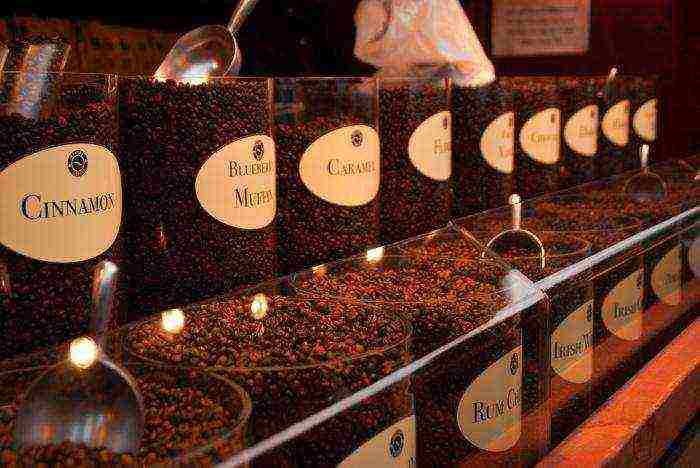 Gourmets should also understand how to roast coffee, because this has a significant effect on its taste characteristics. For example, a medium roast coffee will give you a clean, sweet aroma with a nutty flavor. But the same grains with maximum roasting will give a more pronounced smell with inclusions of spices, citrus fruits and chocolate. The nuances of the shades, as a rule, depend on the particular type of coffee. Let me remind you once again that coffee beans should never have a burnt smell.
Gourmets should also understand how to roast coffee, because this has a significant effect on its taste characteristics. For example, a medium roast coffee will give you a clean, sweet aroma with a nutty flavor. But the same grains with maximum roasting will give a more pronounced smell with inclusions of spices, citrus fruits and chocolate. The nuances of the shades, as a rule, depend on the particular type of coffee. Let me remind you once again that coffee beans should never have a burnt smell.
It is best to store Arabica coffee beans in a hermetically sealed jar, in a dry and dark place. Make sure that moisture does not get inside. It is better to take out each new portion with a special spoon, which can be put inside the container. And then, grinding aromatic beans and making coffee to your liking - espresso, latte, or Turkish - you will get a fragrant drink that will help you to cheer up at the beginning of a new day.
The whole world loves coffee. It is both the most successful commercial product and the most valuable international commodity after oil. There are about 20 million farming families in the world, about 100 million people depend on it as a material means of subsistence.
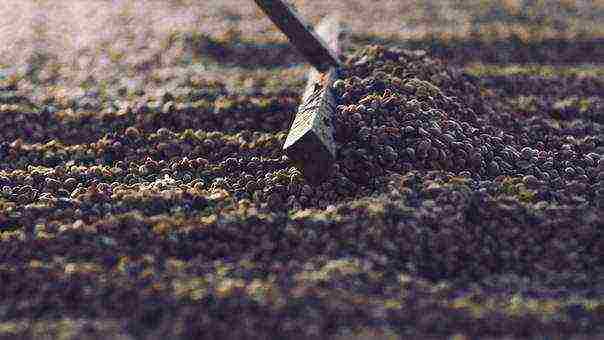
A complex process stands between us and the receipt of this drink: red berries are harvested from coffee trees, the pulp of these berries is removed through various treatments, and then their seeds are subjected to an equally complex roasting process.It is important that the roasting is local, that is, it takes place in the same country (city) where coffee is consumed. And this is another complication.
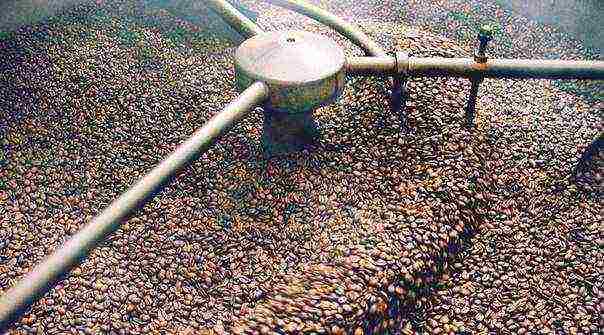
On the botanical side, coffee is a shrub of the Rubiaceae family. The exact classification of coffee has not been agreed since the 18th century. There are about 25 large species belonging to tropical Africa and some islands in the Indian Ocean. Difficulties arise from large changes in plants and seeds. All species are arboreal, however, they range from small shrubs to large trees 10 m high, the leaves can also be different: yellowish, dark green, bronze.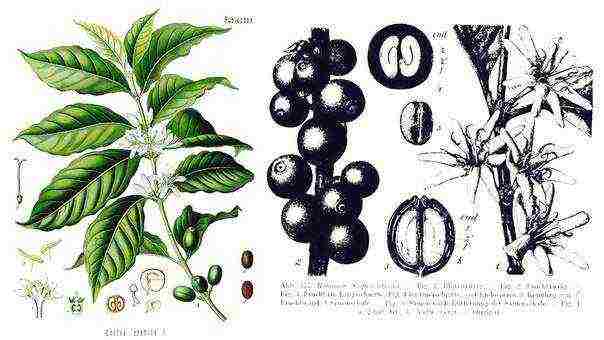
The most important economically are Arabica and Robusta. There are also Liberica and Ekzelsa, which are grown on a smaller scale.
Let's dwell on Arabica - the main component of the specialty coffee market.
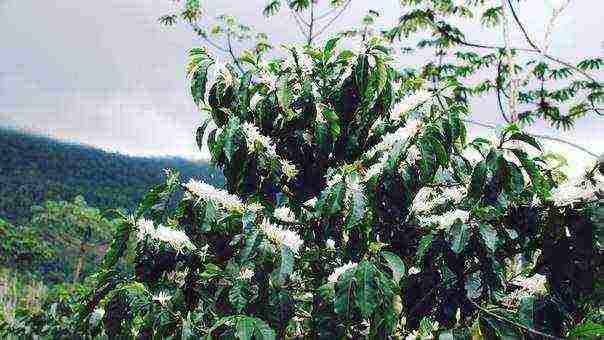
Coffea Arabica was first described by Karl Linnaeus in 1753. Genetically Arabica differs from other varieties in that it has four chromosomes instead of two. The tree grows from 2 to 8 meters in height, the leaves are bright green, glossy. The fruits are oval in shape, usually they contain two flat grains, when there is only one grain in the berry - a natural mutation - this is called Peaberry.
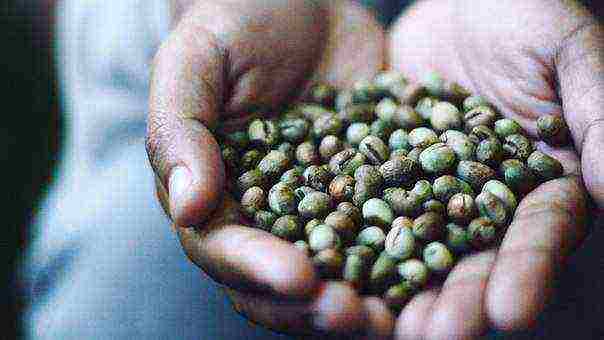
The berries are picked by hand. This is partly due to the fact that coffee grows in the mountains, where cars cannot reach, but mainly because the person picking berries does it carefully and selects the ripe ones. The best farmers harvest three times a season to harvest more ripe berries.
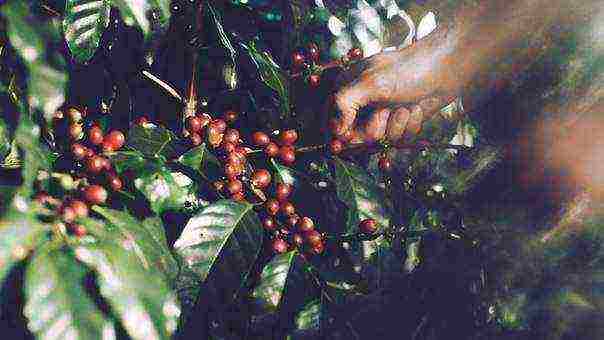
Varieties and varieties have a profound influence on the taste in the cup, to understand what to expect from a particular variety, you need to know what flavor it has.
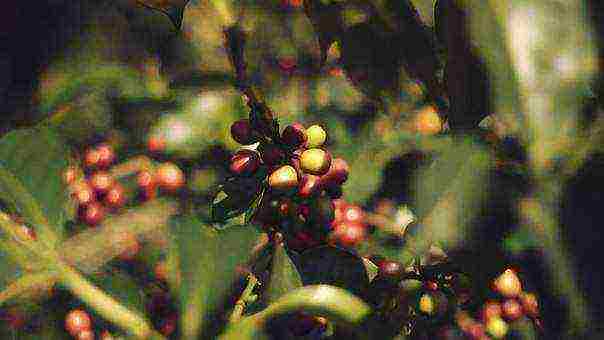
There are two types of Arabica in the world: Typica and Bourbon, from which, in turn, its other subspecies were derived.
Typica is the original Arabica, a classic type of coffee tree found in the Kaffa Rainforest region of Ethiopia. The trees have a conical shape and they grow at a slight slope, the leaves are copper-colored, and the berries are extended, oval in shape. Typica has excellent cup quality, special sweetness, purity and a rounded body.
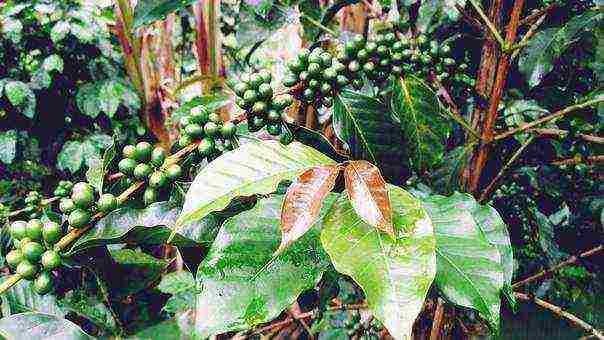
Bourbon was named after the island of Bourbon, where it was first grown. Later, this island was renamed Reunion, it is located east of Madagascar in the Indian Ocean. Coffee trees have many side branches, the angle of inclination is less than that of Typica, the leaves are wide, wavy at the edges and small berries that grow tightly to each other. The berries ripen quickly, but they are more fragile and less resistant to weather conditions.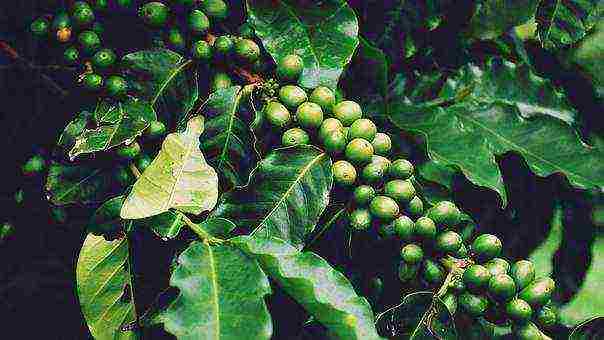
Bourbon also has several varieties with a mutation of the recessive gene that affects the color of the berry: red, yellow and pink. On the palate, Bourbon has a slight body, balance, complex acidity and caramelly sweetness.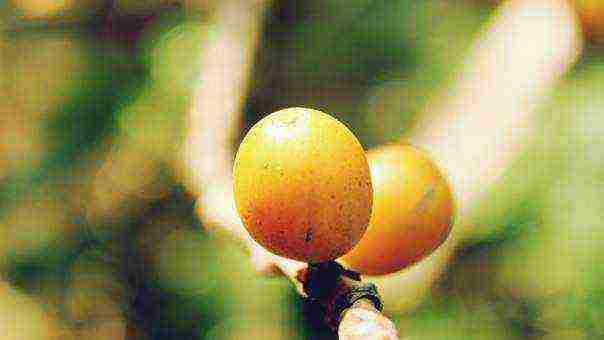
Caturra is a Brazilian variety, a Bourbon mutation. Gives high performance, but needs constant care. It is also called a dwarf variety for its short stature. Caturr has a thick stem, many branches, large leaves with wavy edges, similar to Bourbon. This species adapts well to any environment, but is more common in Colombia, Nicaragua and Costa Rica. The flavor profile includes bright citric acidity, lean body and mild sweetness.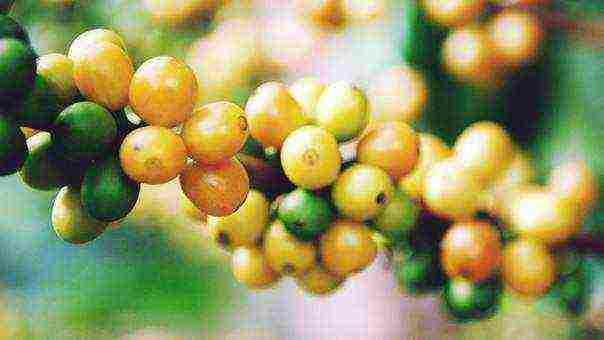
Pacas is also a bourbon mutation. A view that was discovered in El Salvador in 1949 by the Pacas family. Differs in high yields at high altitudes and better than bourbon, disease resistance. Has a loose body and bright acidity.
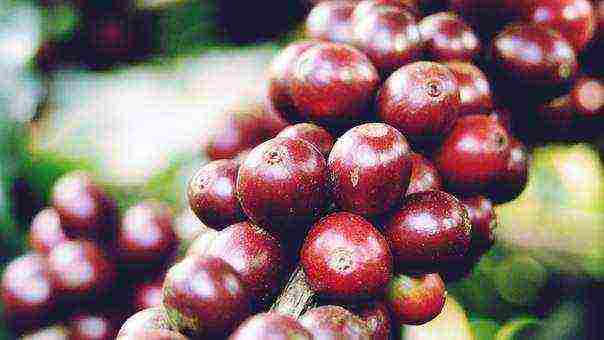
SL-28 as well as SL-34 are Kenyan varieties bred by Scot Laboratory. They became the basis for the development of coffee farming in Kenya and Tanzania in 1935-1939. SL 28 - launched in 1931 in Tanganyika. The tree has broad leaves with bronze-colored tips. Fruiting is not very intense, but produces large berries.The goal of the Scot laboratory, where the variety was bred, is to create a plant that produces high quality fruits with good yields and resistance to various diseases. On the palate SL-28 citrus acidity, sweetness, balance. SL 34 is a mutation from the Lorecho plantation in Kabet. It is appreciated for its high yield in different climatic conditions. Also resistant to drought and heavy rainfall. The flavor profile is composed of complex acidity, dense body, sweetness and clean aftertaste.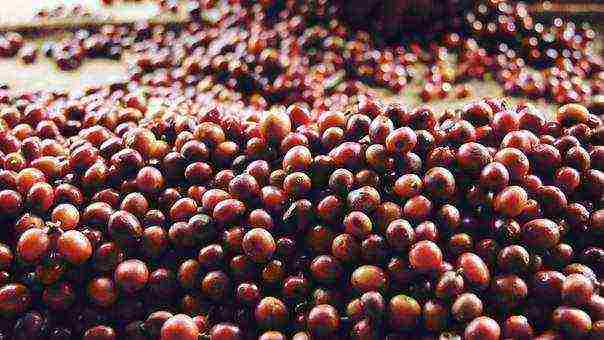
Timor is a unique cross between Arabica and Robusta, which has become a salvation in resistance to brown rust, a disease that affects many types of coffee trees. Timor has an average body density with a bright taste and acidity.
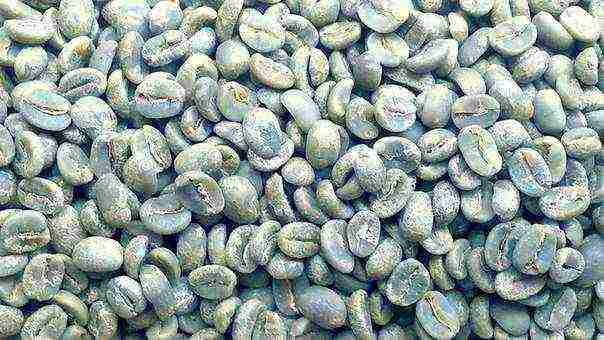
Catimor is a cross between Timor and Katurra. The variety was created in Portugal in 1959. It ripens quickly, with high productivity and productivity. Catimore is relatively small in stature, but has large coffee berries and beans. With a growing height of 1000 meters or more, this variety has the best quality.
Mundo Novo is a natural hybrid between Typica and Bourbon. First discovered in Brazil, the tree is strong and disease resistant. Mundo Novo has a high productivity, but matures a little later than other types of coffee. Has a dense body, sweetness, low acidity.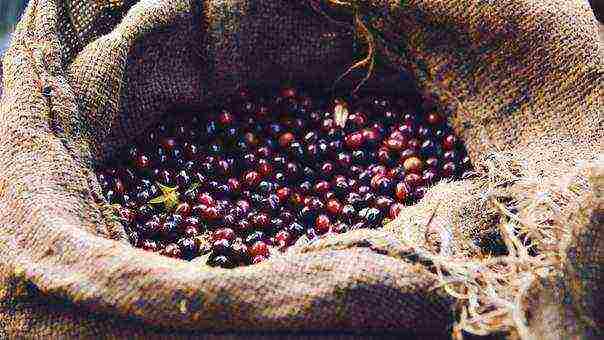
Catuai - has a high resistance to natural factors, grows at high altitudes and with high productivity. Catuai originated in Brazil and is a hybrid of Mundo Novo and Caturra. Currently it grows mainly in Central America. Ripe Katuai can be red or yellow. It is believed that the red Catuays have the purest taste, but both have a high acidity in taste.

Ethiopian Heritage - About 1000 varieties from Ethiopia's “wild forests” are in production. One of these varieties was adopted in Latin America as the first variety to be grown in the new light. Ethiopian heritage has the best flavor characteristics. As a rule, it is dry processed, has a medium density with acidic fruit-wine notes, when wet processed it has a light body, but complex floral and citrus notes.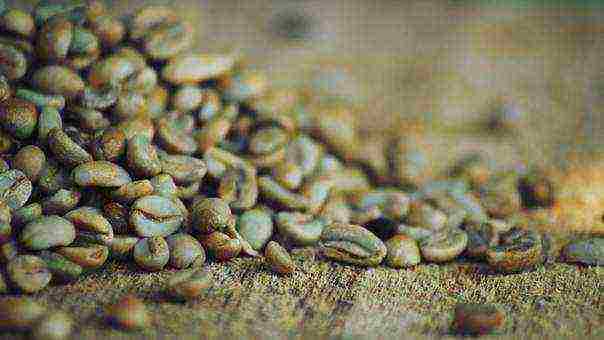
Geisha is an extremely rare type of coffee that originated in Ethiopia. The trees grow at very high altitudes, have beautiful elongated seeds and leaves. In 1998, there were extreme rains that brought the coffee plague to Panama. Peterson, one of the region's coffee farmers, was able to save several varieties, one of which was Geisha. When the coffee tree is planted in a different area, its taste has changed dramatically, so to maintain its original brightness, it is grown on the original slope. Geisha has a clean and sweet, fruity taste and aroma.
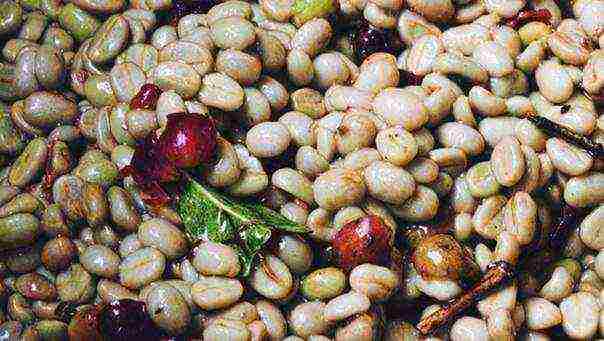

As you can tell, the inscription on the packaging of 100% Arabica coffee does not tell us anything about the quality of this product. You should always know as much as possible about the right coffee. Do not hesitate to ask about it in coffee shops, in stores. If this is a specialty coffee, you will get as much information as possible, because there is no point in hiding anything, the point is in full quality control. From farmer to consumer.
